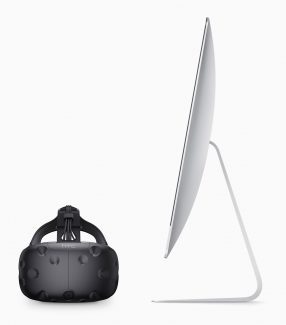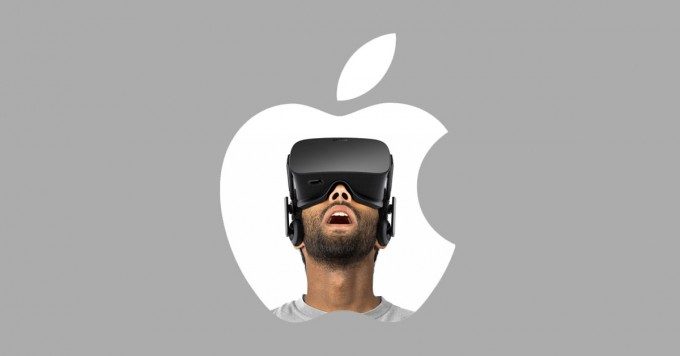Apple has shown that it’s getting serious about the VR on Mac with platform-spanning VR announcements crossing both hardware and software at last year’s WWDC event. With SteamVR and the Vive now up and running on MacOS, eyes turn to Oculus, but the company isn’t ready to commit.
Update (6/4/18): This week is Apple’s WWDC 2018 event and it’s been one year since the company announced that SteamVR (and Vive) support was coming to MacOS. Since then, the first Macs with VR Ready specifications have begun shipping, and external GPUs for modern Macs and MacBooks are now officially supported out of beta, allowing systems without a dedicated internal GPU to meet VR Ready specifications. And while there aren’t many supported games yet, SteamVR and the Vive on MacOS is now fully functional and gets updated in sync with its Windows counterpart.
Though Apple didn’t touch on VR during its keynote, at WWDC this week the company is hosting a developer session dedicated to the platform’s newest VR graphics capabilities, as well as a ‘lab’ session offering hands-on on guidance for developers building VR applications on MacOS.
Checking in with Oculus—which supported Mac early on but “paused” support for the OS in 2015—the company’s stance doesn’t seem to have changed in the last 12 months—a spokesperson for Oculus offered us the same response as last year: “Oculus is committed to bringing PC VR to as many people as possible, but no news on MacOS support at this time.”
Original Article (6/7/17):
The “Pause”
Once upon a time, back in the days of the DK1 and DK2 development kits, Rift support for MacOS (then called OS X) was alive and well. It wasn’t uncommon to see developers building and running VR applications on Apple computers. Then in mid-2015, the company “paused” their support of MacOS (and Linux) in order to focus on the impending launch of the consumer Rift headset with Windows as the only compatible platform.
The move made plenty of sense, not only because Windows is far and away the biggest PC platform for gaming, but especially because the minimum hardware Oculus was recommending for VR was not available from any Mac computer at that point. At the time the company said they planned to “get back to development for OS X and Linux but we don’t have a timeline.”
Vive and SteamVR on MacOS, What About Rift?


Fast forward two years later to this week; Apple has made a slew of VR announcements including new computers that do indeed meet Oculus’ recommended hardware requirements. Additionally, the company announced that Valve is bringing SteamVR to MacOS, which will bring Vive support along with it. And while SteamVR supports the Rift on PC, it relies on elements of the Oculus PC SDK to function, which means Rift support on MacOS won’t be seen officially until Oculus is ready to commit to it.
For now, Oculus’ stance on Rift support for MacOS remains unchanged. When we asked the company for an update in light of this week’s Apple VR announcements, a spokesperson offered, “We’re committed to bringing PC VR to as many people as possible, but no news on MacOS support at this time.”
Not If, But When (Probably)
Back in 2016, Oculus founder Palmer Luckey (who at the time was still with the company), said about VR support for Apple computers, “If they ever release a good computer we will [support Mac OSX].”
It seems inevitable that Oculus will support the Rift on MacOS, but the big question is when. It could still be a while yet.
Though you can finally buy an Apple computers that meets VR Ready specifications, it’s only some of their high-end devices—and the Apple high-end is ultra high-end for everyone else. With an estimated PC market share around 7.4%—and only the newest, high-end models of that 7.4% being VR Ready—it’s likely to take a long time before any significant number of VR end-users are using VR Ready Macs and iMacs.
At this particular moment in the VR industry, perhaps the more valuable addressable market of Apple users is developers. With one of the most successful app ecosystems in the world, Apple has attracted a large and loyal developer community. Supporting Rift on MacOS would mean easier access for Apple devotees to experiment with and ultimately build for VR; as long as Vive remains the only option for VR on Mac Oculus could be missing out on that unique developer population.
Competition in the Bigger Picture
The user and developer side is one way to look at it, but there’s also the grander scheme to consider as well. Oculus is owned by Facebook, which competes with Apple in a number of realms.
We know that Oculus is developing a standalone VR headset and has huge AR ambitions. Meanwhile, Apple is rumored to be working on their own VR and/or AR headsets—and just launched AR development software that will reach “hundreds of millions” of users on iOS devices—which would put the companies in direct competition in the high-risk realm of hardware. That’s just one example of potential broader competitive pressures which could inform Oculus’ commitment (or lack thereof) to MacOS.

